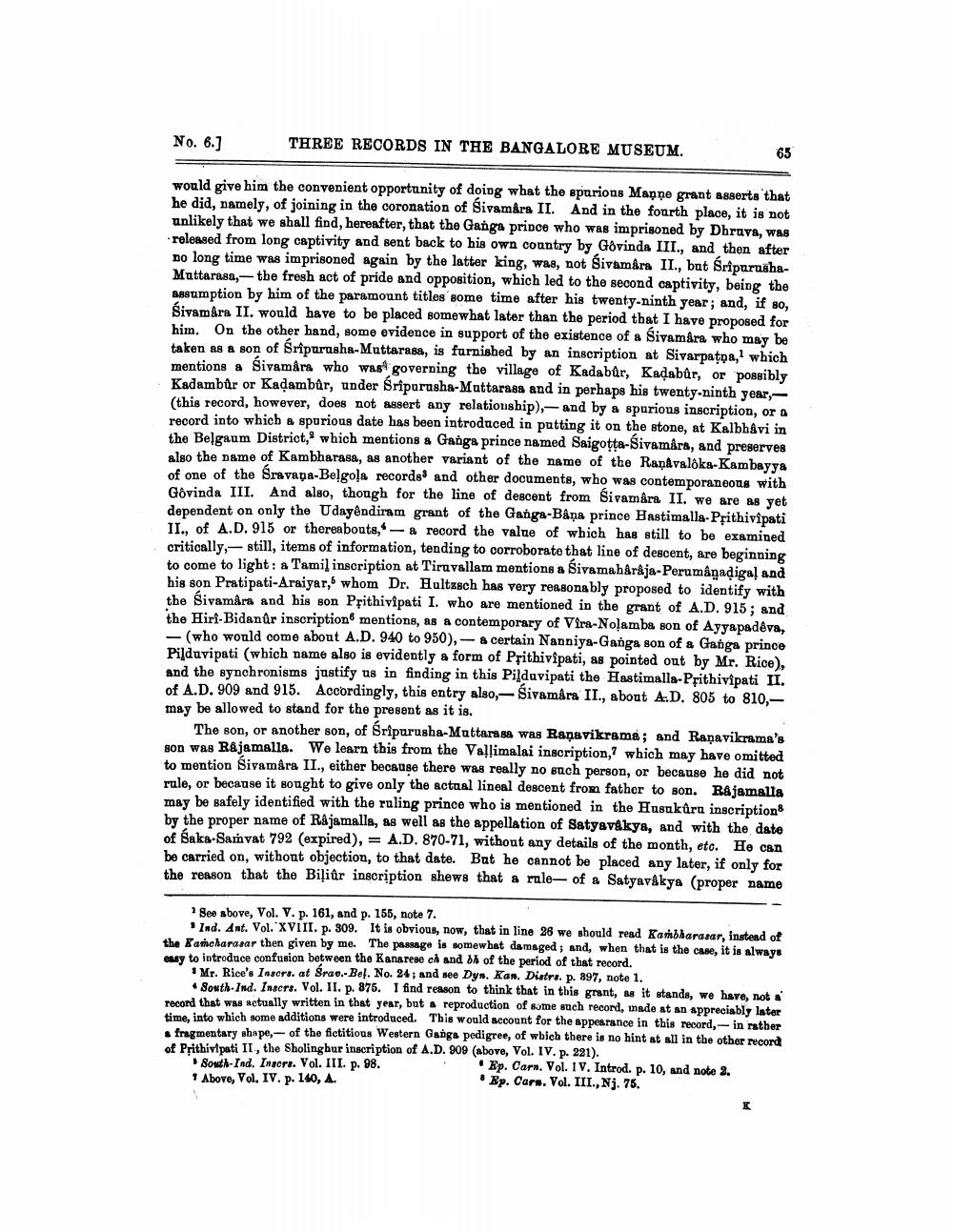________________
No. 6.]
THREE RECORDS IN THE BANGALORE MUSEUM
65
would give him the convenient opportunity of doing what the spurious Manne grant asserts that he did, namely, of joining in the coronation of Sivamára II. And in the fourth place, it is not unlikely that we shall find, hereafter, that the Ganga prince who was imprisoned by Dhruva, was · released from long captivity and sent back to his own country by Govinda III., and then after no long time was imprisoned again by the latter king, was, not Sivam&ra II., but SripurushaMuttarasa, the fresh act of pride and opposition, which led to the second captivity, being the assumption by him of the paramount titles some time after his twenty-ninth year; and, if so, Śivamâra II. would have to be placed somewhat later than the period that I have proposed for him. On the other hand, some evidence in support of the existence of a Sivamara who may be taken as a son of Sripurusha-Mattarasa, is furnished by an inscription at Sivarpatpa,' which mentions a Sivamara who was governing the village of Kadabar, Kadabûr, or possibly Kadambůr or Kadambûr, under Sripurusha-Mattarasa and in perhaps his twenty-ninth year,(this record, however, does not assert any relationship), - and by & spurious inscription, or a record into which a spurious date has been introduced in putting it on the stone, at Kalbhavi in the Belgaum District, which mentions a Ganga prince named Saigotta-Sivamára, and preserves also the name of Kambharasa, as another variant of the name of the Ranávalóka-Kambayya of one of the Sravaņa-Belgo!& records and other documents, who was contemporaneous with Govinda III. And also, though for the line of descent from Sivamâra II. we are as yet dependent on only the Udayêndiram grant of the Ganga-Bana prince Hastimalla-Prithivipati II., of A.D. 915 or thereabouts, & record the value of which has still to be examined critically, -still, items of information, tending to corroborate that line of descent, are beginning to come to light: a Tamil inscription at Tiruvallam mentions a Sivamahåråja-Perumânadiga! and his son Pratipati-Araiyar, whom Dr. Hultzsch has very reasonably proposed to identify with the sivamåra and his son Přithivipati I. who are mentioned in the grant of A.D. 915; and the Hiri-Bidanur inscription mentions, as a contemporary of Vira-Nolamba son of Ayyapadeva, -(who wonld come about A.D. 940 to 950), - & certain Nanniya-Ganga son of a Ganga prince Pildavipati (which name also is evidently a form of Prithivipati, as pointed out by Mr. Rice), and the synchronisms justify us in finding in this Pilduvipati the Hastimalla-Prithivipati II. of A.D. 909 and 915. Accordingly, this entry also,-sivamara II., about A.D. 805 to 810,may be allowed to stand for the present as it is.
The son, or another son, of Sripurusha-Muttara sa was Raņavikrams; and Rapavikrama's son was R&jamalla. We learn this from the Vallimalai inscription, which may have omitted to mention Sivamâra II., either because there was really no such person, or because he did not rule, or because it sought to give only the actual lineal descent from father to son. Rajamalla may be safely identified with the ruling prince who is mentioned in the Hustkůru inscription by the proper name of Rajamalla, as well as the appellation of Satyavákya, and with the date of Saka-Saṁvat 792 (expired), = A.D. 870-71, without any details of the month, etc. He can be carried on, without objection, to that date. Bat he cannot be placed any later, if only for the reason that the Biļiûr inscription shews that a rale- of a Satyavákya (proper name
Bee above, Vol. V. p. 161, and p. 155, note 7.
Ind. Ant. Vol. XVIII. p. 309. It is obvious, now, that in line 26 we should read Kambharasar, instead of the Kanoharasar then given by me. The passage is somewhat damaged; and, when that is the case, it is always emy to introduce confusion between the Kanarese ch and bh of the period of that record.
Mr. Rice's Insere, at Srae. Bef. No. 24; and see Dyn. Kan. Distre. p. 897, note 1.
* South Ind. Insers. Vol. II. p. 875. I find reason to think that in this grant, as it stands, we have, not a record that was actually written in that year, but a reproduction of some such record, made at an appreciably later time, into which some additions were introduced. This would account for the appearance in this record, in rather
fragmentary shape, of the fictitious Western Gangs pedigree, of wbich there is no hint at all in the other record of Prithivipati II, the Sholinghur inscription of A.D. 909 (above, Vol. IV. p. 221). South Ind. Ingers. Vol. III. p. 98.
Ep. Carn. Vol. IV. Introd. p. 10, and note 2. + Above, Vol. IV. p. 140, A.
• Ep. Caro. Vol. III., Nj. 75.




